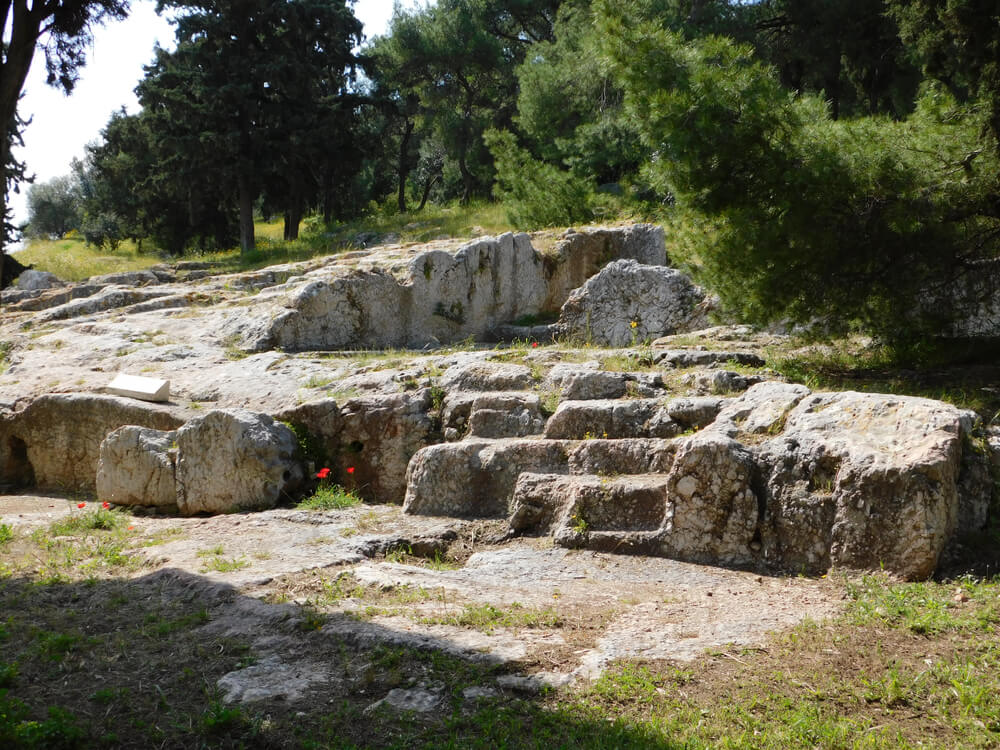Easy Guide to Visiting the 7 Hills of Athens, Greece
Heading to the capital city of Greece? Find out everything you need to know about visiting the 7 hills of Athens, including the Acropolis.

Nestled in the heart of Greece’s capital city lies a collection of seven enchanting hills known as the Hills of Athens. They are all full of captivating history and ancient myths that have shaped the city’s rich heritage.
Whether you are drawn to the cultural significance of each hill or enticed by the breathtaking vistas they offer, exploring these hills are a must for any visitor.
Let’s get started…
The Seven Hills in Athens
The Acropolis

Location
Acropolis Hill is a renowned symbol of the ancient world. Perched on a craggy rock, it stands majestically above the city’s heart.
While it is believed to have been inhabited since the fourth millennium BC, its location offers panoramic views of Athens, adding to its magnificence and allure.
Fun fact: What was a high hill or city called in ancient Greece? An acropolis.
Significance
The Acropolis represents the birthplace of democracy and showcases the architectural and artistic brilliance of ancient Greece.
The site is also considered sacred, housing temples dedicated to deities such as Athena, the patron goddess of Athens.
Today, you can witness the preservation and restoration efforts that showcase the dedication to safeguarding such a special structure.
Important Structures
On your visit there, you can explore architectural marvels that have stood the test of time, including the Parthenon, the Temple of Athena Nike, and the Erechtheion.
Fun fact: The upper rock of the Acropolis is actually older than the lower rock layer.
How to Visit
Want to plan your visit to this outstanding hill overlooking Athens?
The most convenient option is to hire a driver from either the Port of Piraeus, Rafina Port or Athens Airport. From the Airport to the center of Athens, it will take you 50 minutes.
You will have to purchase a ticket to visit. Book a guided tour if you want a deeper understanding of the site’s history and significance.
Areopagus Hill

Location
Areopagus Hill is a vast rocky outcrop located northwest of the Acropolis.
When visiting, you will have beautiful panoramic views of the city, including the Ancient Agora and Acropolis.
Significance
What is the significance of Areopagus Hill?
In ancient times, it served as the meeting place of the Council of Elders and was associated with important trials.
During the Roman period, the hill was known as Mars Hill after the Greek God of War.
Today, it remains a popular tourist destination due to its rich history and unforgettable views.
Important Structures
As you climb the stone steps to the summit of Areopagus Hill, you can observe traces of former structures carved into the rock.
Among them is a temple, and it is believed that the Apostle Paul, one of the first people to spread the word of Christ, stood at this location to address the Areopagus county and promote the virtues of Christianity.
Also, below the hill is a sanctuary dedicated to the mythical Erinyes—three goddesses who punished men for murderous crimes.
How to Visit
To reach Areopagus Hill, you can take the metro and get off at the Acropolis station, about a 20-minute walk away.
Once you arrive, you can climb the hill to explore its historical remnants and enjoy the stunning views.
Pro tip: It has become a popular spot for locals to go for sunset, as you can witness the picturesque views of Athens and its surrounding hills.
Philopappou Hill

Location
Situated adjacent to the Acropolis and Areopagus Hills in Athens, Philopappou Hill offers breathtaking views of the cityscape.
Significance
To understand this site’s significance, you need to know where the name Philopappou came from.
It is derived from Gaius Julius Antiochus Philipappos, a member of the royal family of Commagene, a small Hellenistic Kingdom from the north of Syria and the southeast of Turkey.
The hill is home to the Philopappos Monument, a memorial dedicated to Gaius, believed to have been a generous supporter of ancient Athens.
Important Structures
At this hill in Athens, you will be in awe of the magnificent marble tomb adorned with statues depicting Philopappos, his father, and his son.
Also, it features the Dora Stratou Theatre on its south side and the Socrates prison on its west side, adding to its historical significance.
How to Visit
Again, you can book a car from Athens Airport, Port of Piraeus or Rafina Port. From the Port of Piraeus to Athens, it will take you 45 minutes.
Otherwise, the Neos Kosmos and Syngrou Fix Metro Stations are located nearby.
As you explore the well-marked paths that wind through the scenic landscape, take your time to enjoy the panoramic views of Athens, including the awe-inspiring Acropolis.
Lycabettus Hill

Location
Lycabettus Hill is in the upscale district of Kolonaki, where you can find a mixture of luxury shops, fine dining establishments and refined streetscapes.
This iconic landmark will provide you with stunning panoramic views of Athens, including the Acropolis and the Saronic Gulf.
Fun fact: This Athens hill is the highest point in the city. Want more fun facts? Read our 21 Fun Facts That’ll Blow Your Mind About Athens.
Significance
According to Greek mythology, Lycabettus Hill was formed when Goddess Athena was assisting in the construction of the Parthenon and dropped a rock over Athens.
It’s said that many secrets are held on the site, including hidden caves and tunnels used for military reasons.
Important Structures
Notable structures on this hill in Athens include the historic St. George Church, a striking whitewashed structure dating back to the 19th century.
Another prominent attraction is the Lycabettus Open Theatre, a massive theater constructed in 1964 on the grounds of a former quarry.
Enjoy the cultural performances and immersive experiences which take place there.
As you explore the southern slopes, you will also discover remnants of ancient and contemporary landmarks, including the ruins of the Roman reservoir, the neo-classical Gennadius Library and the Moni Petraki, which once served as a monastery.
How to Visit
The closest metro station, only a seven-minute walk away, is called Megaro Moussikis.
Once you arrive, you can explore this hill in Greece in several ways. A fun option is to ride the Lycabettus Funicular, which has been operating since 1965. It’s a convenient way to get to the hill’s summit.
Otherwise, you can also take a scenic hike along the path leading to the top.
Pro tip: Be sure to check for any performances at the open theater during your visit. Otherwise, book a table at Orizontes restaurant, which not only has breathtaking views of Athens, but also delicious cuisine.
Ardittos Hill

Location
Ardittos Hill is next to the Panathenaic Stadium in the heart of Athens, Greece.
It offers unparalleled views, including the magnificent Acropolis.
Significance
Ardittos Hill’s origins trace back to the 4th century BC. Over the centuries, it has undergone significant architectural and structural transformations.
The mythical local hero Ardittos once resolved conflicts and quarrels with his powerful speeches at the top of the hill.
It was also a significant location for Athenian judges to swear their oath of justice, honoring Ardittis.
Important Structures
The main structure on Ardittos Hill is the Panathenaic Stadium, also known as Kallimarmaro. It is one of the only stadiums in the world built entirely of marble.
After restoration in the late 19th century, it became the site of the first modern Olympic Games in 1896.
How to Visit
You can walk to Ardittos Hill easily from either Syntagma or Evangelismos metro stations.
Two main entrances provide access to the park, one next to the Panathenaic Stadium’s entrance and another at the backside.
Exploring Ardittos Hill offers a peaceful stroll along its paved paths and dirt trails, where the shade of the pine trees provides relief.
Hill of the Nymphs

Location
The Hill of the Nymphs is situated southwest of the Acropolis. It is part of a complex of hills that includes the Pnyx and the Hill of Philopappos.
Significance
Of the mountains in Athens, this one served as a sacred site dedicated to The Nymphs, who were ethereal beings associated with nature and the human soul.
The hill served as a gathering place in ancient Athens during the 5th century BC.
Important Structures
Check out the observatory established in 1843 by Baron Sina, an Austrian-Greek diplomat and philanthropist.
The hill is also adorned with a small garden area open to the public.
Don’t forget to visit the tomb of Kimon. He was an important figure in Athenian history known for his military successes and efforts to strengthen Athens’ position in the ancient Greek world.
How to Visit
Located to the southwest of the Acropolis, it is a short walking distance from the neighborhood of Thiseio.
There is no admission fee.
Pnyx Hill

Location
Pnyx Hill is located in the heart of Athens, Greece.
It is adjacent to the Hill of the Nymphs and the Philopappou Hill.
Significance
Of the hills in Athens, Greece, this one is regarded as the birthplace of modern democracy.
Dating back to as early as 507 BC, it served as a gathering place where the People’s Assembly, known as the Eklesia, would convene to discuss political and social matters as equals.
It was here that influential figures such as Themistocles, Pericles, and Demosthenes delivered persuasive speeches advocating for laws, actions, and resolutions.
Important Structures
The most notable structure is the large flat stone platform known as the bema, which was constructed in the 4th century BC. This is where the People’s Assembly gathered.
Also, don’t forget to check out the parts of a massive retaining wall that supported the northern perimeter of the area.
How to Visit
To visit Pnyx Hill, visitors can access it from Areopagitou Street.
Exploring the site provides an opportunity to experience the historic location as well as witness the remaining structures that played a role in the democratic process.
Pro tip: You won’t be disappointed visiting at sunrise or sunset as the views are magnificent.
Weather in Athens

Knowing what the weather will be like during your visit is an essential part of travel planning.
The most important thing to know is Athens experiences a Mediterranean climate with mild, wet winters and hot, dry summers.
Tourist season peaks during the summer, from June to August, when temperatures can reach 34°C (68°F).
The city becomes a lot quieter in winter, from December to February. Temperatures range from 7-15°C (45-59°F). It will be chilly, and you will likely see some rainfall.
Spring and autumn are fantastic times to explore Athens, with pleasant temperatures and blooming landscapes. March to May offers temperatures ranging from 9-25°C (48-77°F), while September to November has temperatures ranging from 15-28°C (59-82°F).
It’s not unlikely to experience a bit of rainfall during both spring and autumn.
Packing List Essentials for Athens

Instead of telling you what clothing to bring, as this will vary from season to season, let’s look at useful items that will help you explore the hills in Greece.
- Comfortable walking shoes: These are a must. The city is best explored on foot, so it’s essential to have a pair of sturdy and comfortable shoes to navigate the ancient sites and hikes.
- Hat: Even if you are not visiting during the summer, it’s best to have as much protection from the sun as possible, especially since you will be outdoors often.
- Reusable water bottle: Stay hydrated throughout the day by carrying a reusable water bottle. There are drinking fountains and refill stations throughout Athens.
- Travel-size umbrella: No matter what time of the year you visit, being stuck in the rain is never pleasant. Besides, this item won’t take up much space in your luggage.
- Portable charger and adapter: Ensure your electronic devices stay powered up by packing a portable charger and an adapter to fit Greek power outlets.
Map of the Hills of Athens
Now that you’ve brushed up on all seven hills of Athens, this map will help you figure out how to plan your stay there.
How to Get to Athens, Greece

It will take you close to an hour by car from Athens Airport to the city. Theodores Travel Tours is a great option when booking.
Perhaps you are coming from the black sand beaches of Santorini, or the stunning beaches of Rhodes, then a flight is the easiest. It’s only a one-hour flight from Rhodes and about the same from Santorini to Athens.
Take a peek at all the places Bookaway goes in Greece.
A helpful tip for your visit…

Don’t rush the Athens hills. They each hold a significant amount of history, so be sure to book enough time. Spending at least three days in Athens will give you a good feel for the city.
Besides all the history and culture, there are some incredible places to shop, dine and stay.
Need we say more?
FAQ
Acropolis, Areopagus Hill, Philopappou, Lycabettus Hill, Ardittos Hill, Pnyx Hill and Hill of the Nymphs.
The Acropolis is the most well-known, followed by Lycabettus Hill.
It is recommended to spend at least 2-3 days in Athens to properly explore each of the seven hills.
As the summer can be extremely hot, it’s best to visit the 7 hills of Athens in autumn or spring when temperatures are slightly cooler but still pleasant.






